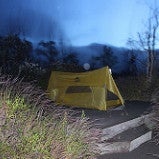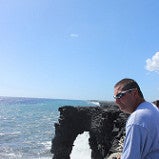Camping and Hiking beautiful lava
If you like to hike, bike, camp with turtles or see lava, Volcano National Park is a must. VNP sits between Kailua-Kona and Hilo and if you do the drive from Kona, you will have a nice drive through the mountains and travel through little villages, mostly supported by the farming industry, specifically macadamia nuts and coffee. There are many local places you can visit during your journey. You can sample different kinds of coffee and I believe that we passed a few wineries, but it wasn’t what I was keeping my eye out for. While driving to VNP, if you think you need any supplies, stop in one of these villages. There are a few that have a larger grocery store, but once you get to Volcano (the town VNP is located) there is one small gas station store and a true value hardware (which has a little bit of everything).
There is an entry fee into VNP, but it is good for 7 days. The first thing you come to in the park is the Visitor’s Center. There are restrooms and water fountains located within the visitor’s center. There is also a walk through information area and a gift shop. The Rangers there are knowledgeable and if you want to find out where your best chance to view lava flowing is, listen to the rangers talk given by the 3-D park map. They have a ranger who speaks about the park and the lava flow every half hour or so.
There are several hiking trails in the park, some more touristy then others. If you want to do the touristy hikes (which are generally short and easy, but offer great things to see), do them early in the morning, (get started by 8:00am) and you will beat the tour busses. We did the Thurston Lava Tubes first thing in the morning, before 8:00am. It was helpful that we were still on Pittsburgh time as we were up early that morning. There were only 2 people on the trail, which is really just a walk through the lava tube. It is less than a half mile and a very easy walk. This is one of the first hikes on the Chain of Craters Drive and by 11:00 the surrounding parking lots will be full…with lots of busses.
Driving the Chain of Craters Drive you will pass many trail heads and areas of interest. Most of it is old lava flows, which are identified by the year of the flow and the dead crater. The landscape is vast and very cool. You can look at the hillside of the volcano and see the distinct path of each lava flow.
We also hiked the Sulphur Banks Trail. This trail is a paved/boardwalk trail that is about a mile. The hike is easy and you will get to see many steam vents. The trail also had lots of wild life as in birds and little critters and the Sulphur banks were very colorful. There were a few people on this trail. It is on the Chain of Craters Drive but it is at the end of the loop road if you start at the visitor’s center. It is one of the first trails you get too if you start on the Chain of Craters Drive and drive towards the Jagger Museum. Make sure to stop the Jagger Museum it is the best place to see the current active lava crater on Kilauea. As of today, 9/13/2016 you should be able to see the glow of the lava lake inside the crater. The lava was not flowing when we visited the park but you could still see the steam coming out of the crater. It was a beautiful site to see at night…pictures would do it no justice.
We attempted to hike the Kilauea Iki trail which is a 4-mile loop trail that crosses a lava crust at the bottom of an inactive crater. As we started the decent into the crater the trail was overtaken by a group of high school students, had to be 300 students. We waited for them to pass us on the steps down, but they just kept coming and, kids are not our thing, so we headed back up off of the trail.
We drove to the end of the Chain of Craters Drive. There is a small visitors center and restrooms at the end. From here you can do some lava hikes. That day (December 15, 2015) we were told if there was any lava flowing it would be about a 5-mile hike from the end of the road. We started to do this hike (we were also told that there were doubts that it was flowing) but after about a mile in we turned back. It was about 90 the day and the hike takes you across hardened lava fields. We decided not to do the 5 miles just to be disappointed.
From the end of the road you get an incredible view of the ocean and you can see the Holei Sea Arch. You can also pick up the Puna Coast Trail that takes you along the coast which affords ocean front back country camping. In some cases, with sea turtles. It is a pack in, pack out camping experience and although there are designated camping areas along the trail, there are only rustic facilities.
There are many other trails in the park, enough to write a book. We did not do any of the higher elevation trails as when we were there it was very cold near the top of the hike and we were not equipped with the proper gear for a hike in those conditions.
You can camp in most areas of the park as long as you have a back country permit. The permits are free and you apply at the ranger’s station near the visitor’s center. They will ask you for emergency contact info and your trip plans. They also provide you with a phone number to call to let them know when you have completed your hike. If you do not leave a message on this line, they will contact your emergency contact.
There are two organized campgrounds in the park. Namakanipaio, which is at a higher elevation. I cannot comment on this site as the area was closed due to falling trees that needed maintenance. From what I have read this campsite offers a few more facilities than the other campground, Kulanaokuaiki. Kulanaokuaiki is kind of located in the middle of the park. The access road is off of the Chain of Craters Drive and it seems to go on forever through the lava fields. The road is not great, but we were in a little car and did not have any issues. The road is a dead end that provides a scenic vista looking towards the ocean.
Kulanaokuaiki, has several campsites that are on raised gravel/sand beds and provide picnic tables. There are also some marked walk-in sites over the hill from the designated ones. I can only imagine the view of the crater and the night sky from these sites was more spectacular than from the site we had chosen. At night you could see the glow and the steam from the crater. Right before dawn the skies cleared up and there were millions of stars. They looked so close that you could reach out and grab one. There was an immense amount of fog surrounding the area and it was very cold. Once the sun started to rise it started to rain which created a beautiful rainbow across the sky and over the crater. There are restroom facilities and an emergency call phone at the campsite, but that is about it. You will still need to pack-in and pack-out everything that you need.
We visited the park for 2 days and it was not enough time to really take in the beauty of the park and all it has to offer. If you can afford a third day to explore the park, you will not be disappointed.




